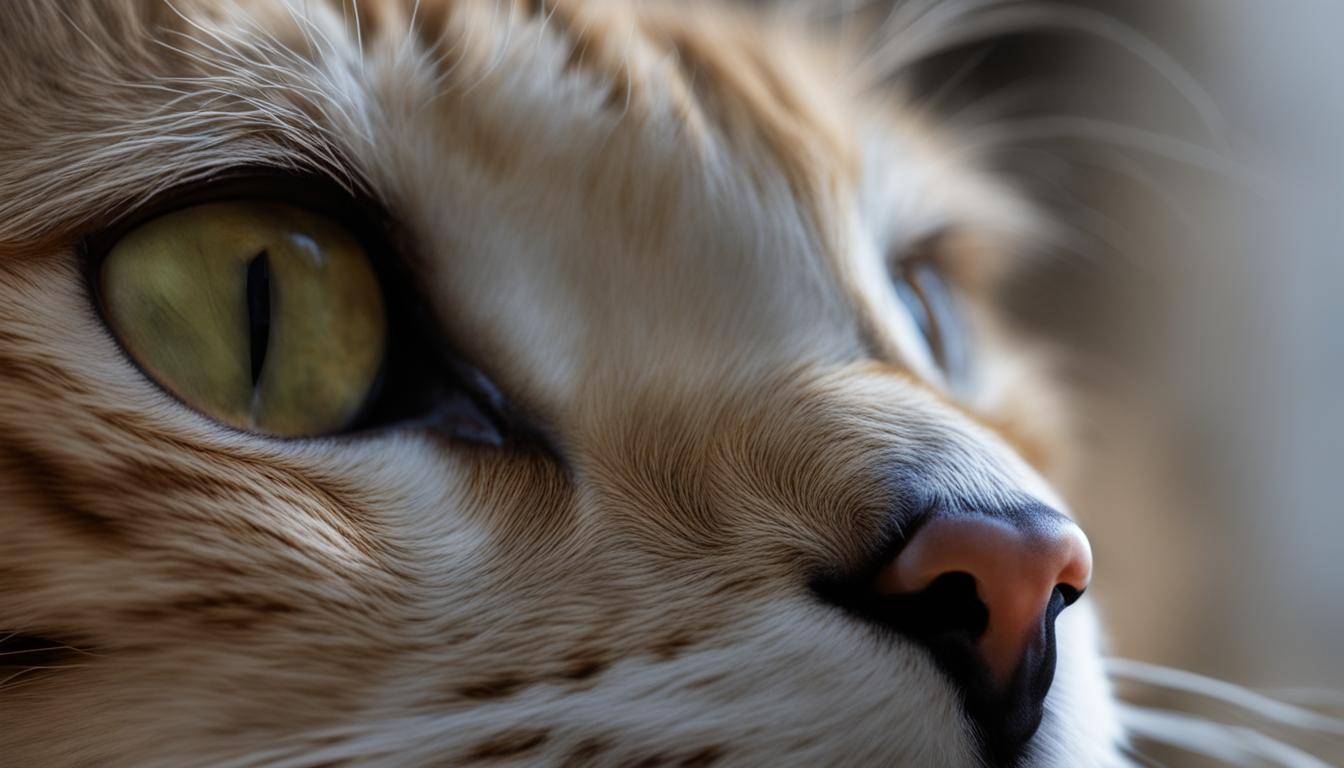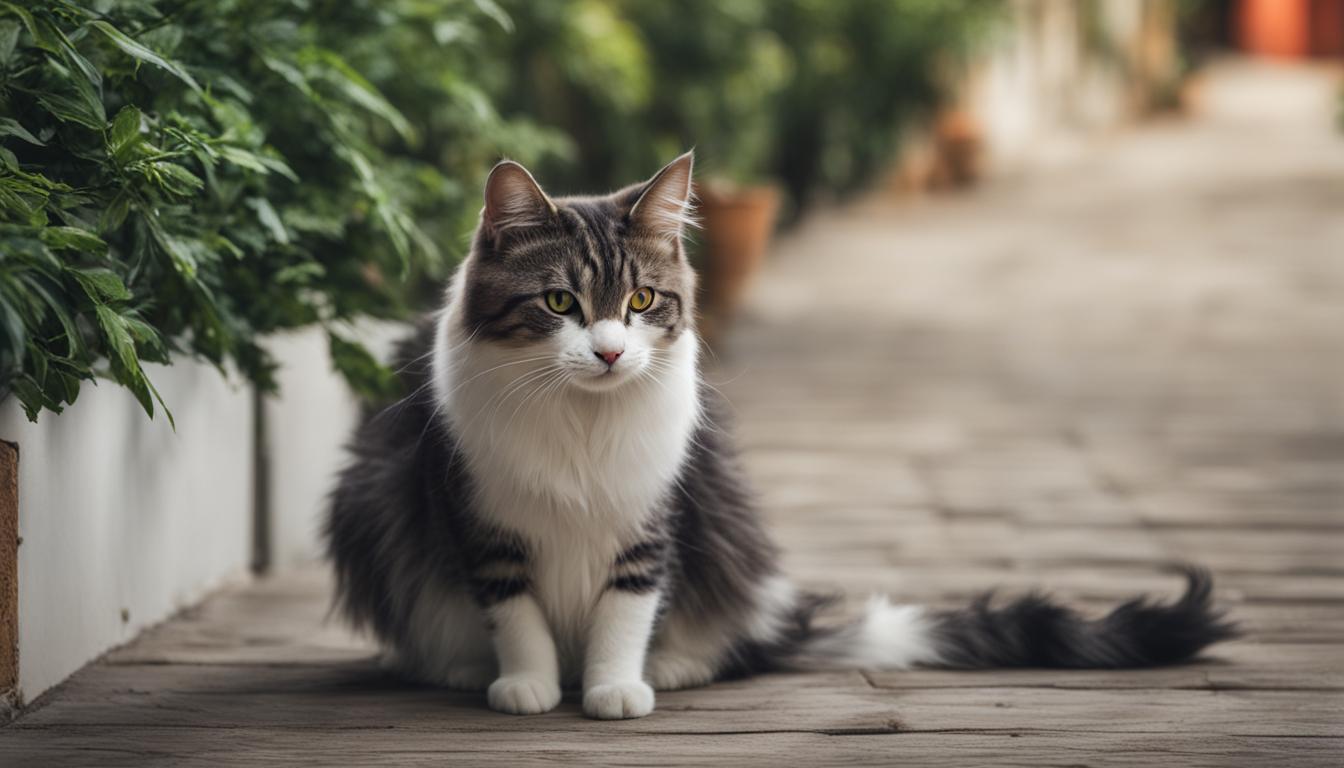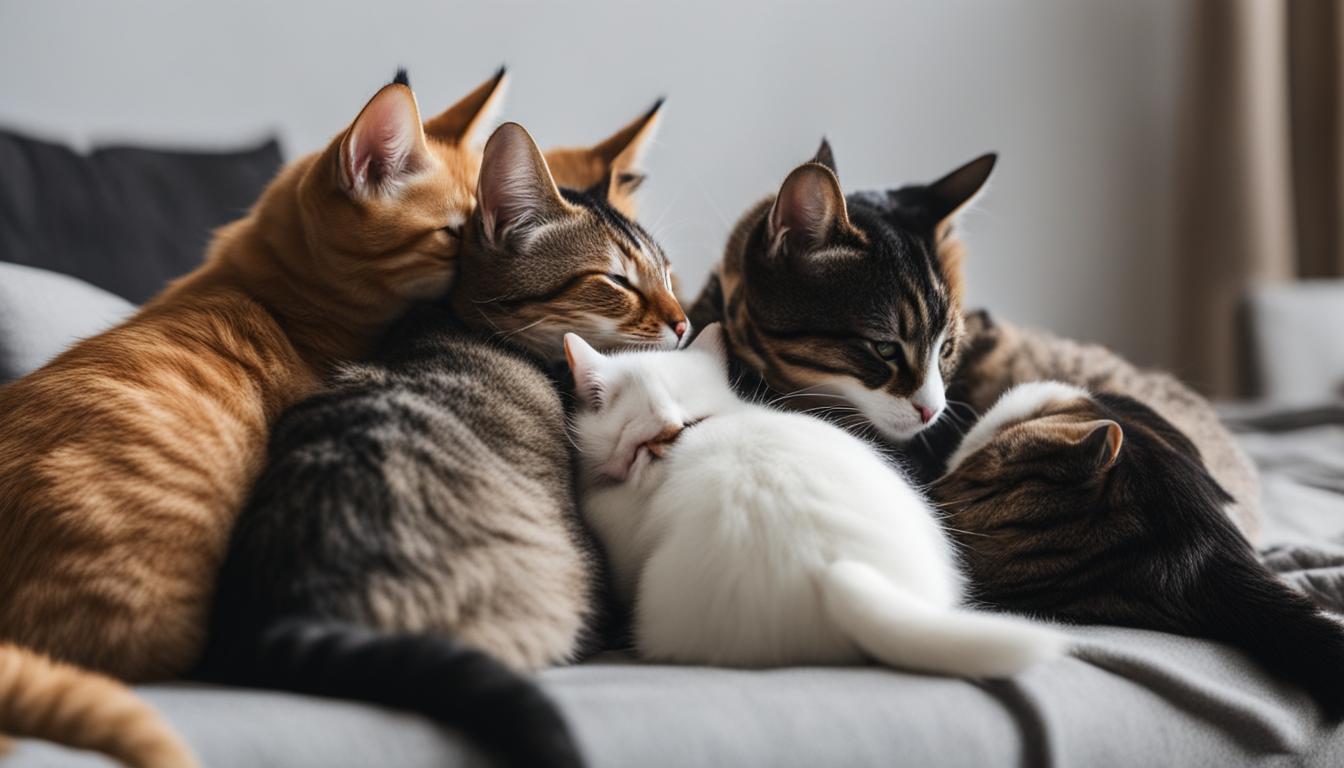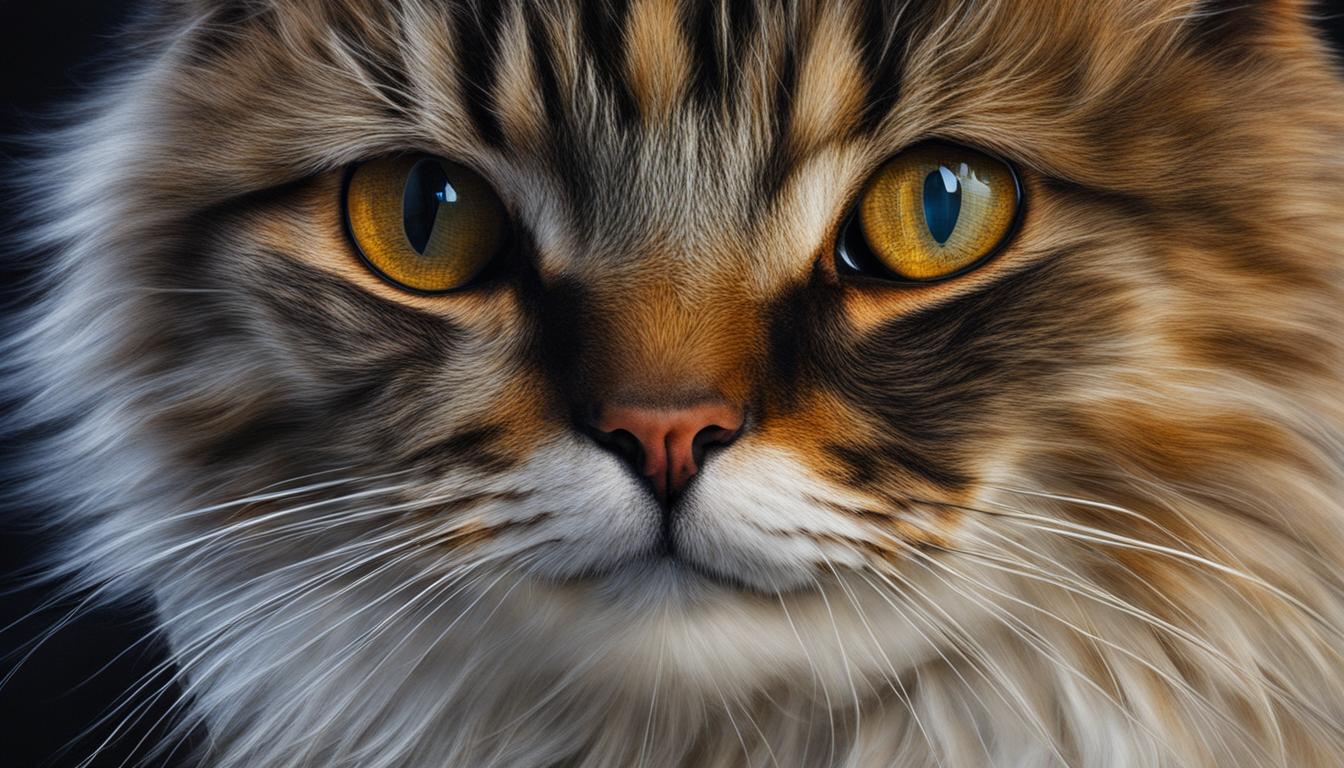Hey there, fellow cat lovers! Today, I want to delve into the intriguing world of feline aggression. We all know that cats can be a mystery wrapped in fur, and when aggression rears its feisty head, it can leave us scratching ours. But fear not, my friends! By understanding the causes of aggression and learning effective strategies to manage it, we can transform our furry companions into peaceful and harmonious members of our households.
Aggression in cats can manifest in various ways, from dilated pupils and flattened ears to raised tails and arched backs. It’s important to nip aggression in the bud and address it promptly, as it can lead to injuries for both other cats and humans, and even result in cats being surrendered to shelters. By identifying triggers and implementing effective management techniques, we can help our feline friends find their Zen and live their best lives.
Key Takeaways:
- Understanding the signs and triggers of feline aggression is essential for cat owners.
- Early intervention and avoiding physical punishment are key strategies for managing aggression.
- Collaborating with a veterinarian to rule out any underlying medical conditions is crucial.
- Play aggression, fear aggression, and petting-induced aggression are different types that require specific approaches.
- Cat body language is a valuable tool in preventing aggression and understanding their needs.
Types of Aggression in Cats and How to Manage Them
Cats can display different types of aggression, each with its own triggers and management approaches. By understanding these types, cat owners can effectively address their cat’s aggressive behavior and create a harmonious environment.
Play Aggression
Play aggression is commonly observed in young cats and kittens. It involves rough play behaviors such as biting, scratching, and pouncing. To manage play aggression, it is important to provide appropriate outlets for play, such as interactive toys and regular play sessions. When a cat becomes too rough during play, redirect their attention to a toy or engage in calm activities to discourage aggressive behavior.
Fear Aggression
Fear aggression occurs when a cat feels threatened or encounters unfamiliar stimuli. Cats may exhibit defensive postures, such as hissing, growling, or crouching. To manage fear aggression, gradual desensitization can be employed. This involves exposing the cat to the feared stimulus in a controlled setting, starting at a distance and gradually increasing proximity. Positive reinforcement, in the form of treats or praise, can be used to reward the cat for calm behavior during these exposures, helping to reduce their fear response over time.
Petting-Induced Aggression
Petting-induced aggression can occur when a cat becomes overstimulated during petting or handling. Signs of petting-induced aggression include sudden biting or scratching. To manage this type of aggression, it is important to pay attention to a cat’s body language and recognize signs of discomfort. Avoid prolonged petting or handling sessions and allow the cat to set their own boundaries. Positive reinforcement can be used to reward the cat for non-aggressive behavior during interactions.
Redirected Aggression
Redirected aggression happens when a cat is unable to directly respond to a source of arousal or frustration. Instead, they may redirect their aggression onto another person or animal. To manage redirected aggression, it is important to remove or avoid the stimuli that trigger the aggressive behavior. Providing a safe space for the cat to retreat to and redirecting their attention to an alternative activity or toy can help prevent future incidents.
Pain-Induced Aggression
Pain-induced aggression may occur when a cat is in pain and reacts aggressively to avoid further discomfort. This can happen in response to touch or movement that exacerbates their pain. To manage pain-induced aggression, it is crucial to work with a veterinarian to address and treat the underlying pain condition. Avoid touching painful areas and provide a comfortable and stress-free environment for the cat to recover.
| Type of Aggression | Triggers | Management Approaches |
|---|---|---|
| Play Aggression | Excessive stimulation during play | Provide appropriate play outlets and redirect attention to toys |
| Fear Aggression | Unfamiliar stimuli or perceived threats | Gradual desensitization and positive reinforcement |
| Petting-Induced Aggression | Overstimulation during petting or handling | Pay attention to body language, set boundaries, and reward non-aggressive behavior |
| Redirected Aggression | Inability to directly respond to a source of arousal or frustration | Remove or avoid triggering stimuli, provide safe space, and redirect attention |
| Pain-Induced Aggression | Presence of pain or discomfort | Treat underlying pain condition, avoid touching painful areas, and provide a stress-free environment |
Understanding and effectively managing the different types of aggression in cats is essential for promoting a peaceful and safe living environment. By employing the appropriate management approaches based on the specific type of aggression, cat owners can help their furry companions thrive and reduce the risk of aggressive incidents.
Understanding Cat Body Language for Aggression Prevention
One of the most effective ways to prevent aggression in cats is by understanding their body language. Cats use various signals to express their emotions, and being able to interpret these signals can help cat owners identify and address potential aggression before it escalates.
Signs of Aggression in Cats
Cats display specific body language cues when they are feeling aggressive. Recognizing these signs can help cat owners intervene and prevent aggressive behavior. Some common signs of aggression in cats include:
- Dilated pupils
- Flattened ears
- Raised tail
- Arched back
- Hissing or growling
These defensive postures indicate that a cat is ready to attack or defend itself. It’s important to pay attention to these signals and give the cat space to avoid any potential confrontation.
Offensive and Defensive Postures
Cats can exhibit both offensive and defensive postures when they feel threatened or aggressive. Offensive postures include a stiff posture, raised tail, direct stare, and constricted pupils. These postures indicate that the cat is preparing to attack. Defensive postures, on the other hand, involve crouching, a tucked tail, flattened ears, and open-mouthed hissing. These postures are a cat’s way of trying to make itself look smaller and are often a sign of fear or an attempt to avoid conflict.
“Understanding cat body language is crucial for preventing aggression. By recognizing the signs and responding appropriately, cat owners can create a safe and peaceful environment for their feline friends.”
By familiarizing themselves with offensive and defensive postures, cat owners can better understand their cats’ emotions and take appropriate action to prevent aggression. This can include removing any perceived threats, providing a calm and secure environment, and using positive reinforcement techniques to encourage non-aggressive behavior.
| Offensive Postures | Defensive Postures |
|---|---|
| Stiff posture | Crouching |
| Raised tail | Tucked tail |
| Direct stare | Flattened ears |
| Constricted pupils | Open-mouthed hissing |
In conclusion, understanding cat body language is essential for aggression prevention. By recognizing the signs of aggression and being aware of offensive and defensive postures, cat owners can effectively intervene and create a harmonious environment for their feline companions.
The Classification of Aggressive Behavior in Cats
When it comes to aggressive behavior in cats, understanding the different types of aggression and their classifications can provide valuable insights into their motivations and triggers. By categorizing aggressive behaviors, cat owners can better identify the underlying causes and tailor appropriate interventions to manage and prevent aggression effectively.
Cat aggression can be classified into several types, including territorial aggression, play aggression, fear aggression, and more. Territorial aggression occurs when cats defend their territory from perceived intruders. It is a natural instinct and can be observed through behaviors like hissing, growling, and physical attacks. Play aggression, on the other hand, is often seen in kittens and young cats engaging in rough play behaviors. While it may seem harmless, play aggression can escalate if not redirected appropriately.
Fear aggression is another common type of aggression in cats. Cats may become aggressive when they feel threatened or encounter unfamiliar stimuli. This aggression serves as a defense mechanism to protect themselves. Understanding fear aggression and its triggers can help cat owners develop desensitization techniques and positive reinforcement strategies to alleviate their cats’ anxiety. By addressing the root cause, cat owners can help their cats feel more secure and reduce aggressive behaviors.
| Type of Aggression | Description |
|---|---|
| Territorial Aggression | Cats defend their territory from intruders |
| Play Aggression | Rough play behaviors often observed in kittens and young cats |
| Fear Aggression | Cats become aggressive when they feel threatened or encounter unfamiliar stimuli |
Recognizing the different types of aggressive behavior in cats is essential for devising effective management strategies. Each type requires a tailored approach to address the specific triggers and motivations behind the aggression. From environmental modifications to behavior and training techniques, cat owners can work towards reducing aggressive behavior and creating a harmonious living environment for their feline companions.
Aggression in Cats: Causes and Triggers
Understanding the causes and triggers of aggression in cats is crucial for cat owners looking to address this behavioral issue. Aggression in cats can stem from various factors, including fear and stress, as well as pain. Identifying and addressing these underlying causes is essential for effective management and prevention of aggression.
Fear and stress are common triggers of aggression in cats. When cats feel threatened or anxious, they may lash out aggressively as a defense mechanism. It’s important to create a calm and safe environment for cats, minimizing stressful stimuli and providing plenty of hiding places. Additionally, providing opportunities for mental and physical stimulation can help alleviate stress in cats and reduce the likelihood of aggression.
Pain can also be a significant cause of aggression in cats. When cats are in pain, they may react aggressively to avoid touch or movement that exacerbates their discomfort. It’s essential to work closely with a veterinarian to identify any underlying medical conditions that may be causing pain and develop a pain management plan. Addressing the pain effectively can help reduce aggression in cats.
“Understanding the causes and triggers of aggression in cats is crucial for effective management and prevention.”
Common Causes of Cat Aggression:
- Fear and stress
- Pain
Cat owners should be mindful of these potential causes and triggers of aggression and take appropriate steps to manage them. By creating a harmonious environment, addressing any underlying medical issues, and providing enrichment and stimulation, cat owners can help alleviate aggression in their feline companions.

Managing and Preventing Aggression in Cats
When it comes to managing aggression in cats, there are several effective strategies that can be implemented. One key approach is positive reinforcement, which involves rewarding non-aggressive behavior to encourage the cat to exhibit more desirable actions. This can be done through treats, praise, or playtime, reinforcing the idea that calm behavior is more rewarding than aggression.
Another important aspect of managing aggression in cats is environmental modification. Creating a safe and stimulating environment for the cat can help minimize stress and reduce the likelihood of aggressive episodes. This can include providing plenty of hiding spots, interactive toys, and vertical spaces for the cat to climb and explore. By enriching their surroundings, cats are less likely to become bored or frustrated, which can often lead to aggressive behavior.
In addition to positive reinforcement and environmental modification, behavior modification techniques can also play a significant role in managing cat aggression. These techniques involve identifying triggers and gradually desensitizing the cat to them, helping them develop more appropriate responses. For example, if a cat becomes aggressive when approached by strangers, a behavior modification plan may involve gradually exposing the cat to new people in a controlled environment, rewarding them for remaining calm and non-aggressive.
It is worth noting that every cat is unique, and what works for one may not work for another. Consulting with a veterinarian or a veterinary behaviorist is often an important step in managing aggression in cats. These professionals can provide expert guidance tailored to the specific needs and behavior of the individual cat, ensuring that the most effective strategies are employed.

| Strategies for Managing Cat Aggression | Benefits |
|---|---|
| Positive reinforcement | – Encourages non-aggressive behavior |
| Environmental modification | – Creates a stress-free environment |
| Behavior modification | – Helps the cat develop appropriate responses |
| Veterinary consultation | – Provide expert guidance tailored to the cat’s needs |
Conclusion
After exploring the fascinating world of feline aggression, it is clear that managing and preventing aggressive behavior in cats is essential for their well-being and the safety of those around them. By understanding the different types of aggression and their underlying causes, we can take proactive steps to address this common behavioral problem.
Early intervention is key. By recognizing the signs of aggression and taking action before it escalates, we can nip the problem in the bud. Implementing positive reinforcement techniques, such as rewarding non-aggressive behavior, can help redirect a cat’s behavior and reinforce good habits.
Creating a safe and stimulating environment through environmental modification and employing behavior modification techniques can also provide a solid foundation for managing aggression. And when necessary, don’t hesitate to consult with a veterinary behaviorist for expert guidance and a comprehensive management plan tailored to your cat’s unique needs.
In conclusion, by taking a proactive approach and integrating these strategies into our daily lives, we can effectively manage and prevent aggression in cats. With patience, consistency, and collaboration with our trusted veterinarians, we can transform our beloved feline friends into lovable and well-behaved companions for life.
FAQ
What are the signs of aggression in cats?
Cats may display dilated pupils, flattened ears, a raised tail, and an arched back when they are aggressive.
What are the different types of aggression in cats?
Cats can exhibit play aggression, fear aggression, petting-induced aggression, redirected aggression, pain-induced aggression, and territorial aggression.
How can play aggression in cats be managed?
Play aggression in kittens and young cats can be redirected through distraction and positive reinforcement using appropriate toys.
What is fear aggression in cats and how can it be addressed?
Fear aggression occurs when a cat feels threatened or encounters unfamiliar stimuli. It can be managed through gradual desensitization and positive reinforcement.
How can petting-induced aggression in cats be prevented?
Petting-induced aggression can be managed by avoiding uninvited handling and rewarding non-aggressive behavior.
What is redirected aggression and how can it be prevented?
Redirected aggression occurs when a cat is excited by a stimulus but cannot respond directly. It can be prevented by removing or avoiding the stimuli that trigger the aggression.
How can pain-induced aggression in cats be managed?
Pain-induced aggression may occur when a cat is in pain. It can be managed by refraining from touching painful areas and working with a veterinarian for pain control.
What are the causes and triggers of aggression in cats?
Aggression in cats can have various causes, including fear, stress, and pain. Triggers can include unfamiliar stimuli or situations that make a cat feel threatened or anxious.
What are some effective strategies for managing and preventing aggression in cats?
Early intervention, positive reinforcement, environmental and behavior modification, and collaboration with a veterinarian are key strategies for managing and preventing aggression in cats.
What should I do if my cat displays aggressive behavior?
If your cat displays aggressive behavior, it is important to consult with a veterinarian for a proper diagnosis and to develop a comprehensive management plan.
Source Links
- https://www.vet.cornell.edu/departments-centers-and-institutes/cornell-feline-health-center/health-information/feline-health-topics/feline-behavior-problems-aggression
- https://www.aspca.org/pet-care/cat-care/common-cat-behavior-issues/aggression-cats
- https://www.petmd.com/cat/behavior/cat-aggression-fighting-biting-and-attacking





